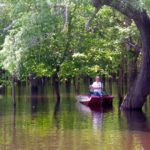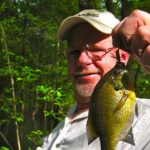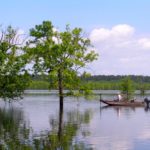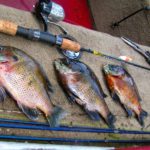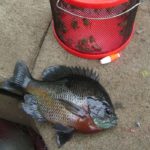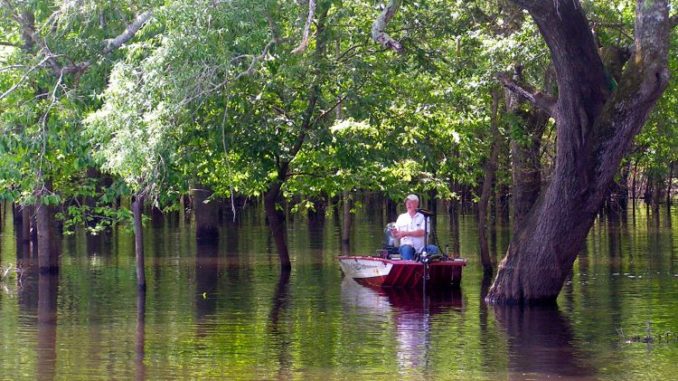
Spring bream fishing beckons anglers off the beaten path
If you can fish it, they will come.
No matter how long or rough the road, how far back off the beaten path or how tough the waters may be to navigate, the determination of fishermen is a perfect example of the old American phrase, “come Hell or high water.”
Put Finch Lake in Union Parish on that list. You have to go through Haile to get there.
Haile is a community on the road to the lake. The road becomes well-traveled in the spring, when some of the best fishing is in the high water, provided by the neighboring Ouachita River rising out of its banks and flooding river lakes and the surrounding woods.
There are numerous species of fish that draw anglers this time of year, but none are more popular than big bluegill bream. The kind that have grown strong swimming in the river current and gorged themselves on a bounty of natural foods in the flood waters.
It usually starts this month, depending on the river stage, and goes on through the summer.
“The thing that is so much fun here is the number of bream,” says Union Parish native Neal Pace. “And it’s the fight that these big old river bream give you. Sometimes you’ll think you’ve got a three pound white perch on there. The quality of the fish is tops, too, because the river comes in there every year, freshens the water and brings a whole new crop of bream. They leave the river and come into the lake to spawn and find plenty of food. And it is the scenery, too. You are in another world back there in the flooded hardwoods and cypress stands. It’s quiet and peaceful,”
Pace is no newcomer to Finch Lake and the Ouachita River backwaters. He grew up taking his grandfather bream fishing there at every chance. His grandfather had severe arthritis and as the oldest grandchild, it fell to Neal to take him fishing…often. That was a chore he didn’t mind. He fondly remembers getting to the Finch Lake Boat Dock in time to rent a small aluminum boat and a paddle and they would spend the day chasing bluegills. And his grandfather taught him a lot.
So how do you find those big beds of spring bluegills?
Pace’s first tip is to fish the edge of the cypress trees. The treelines hold fish most of the time. Look for clearer water. That’s what the fish are looking for, too. And if the water is way back in the woods, head down an old flooded gas pipeline, or an old woods road and look for open areas not far from the newly formed bank.
“One of the key things that makes Finch Lake and its backwaters so good is that the soil up there is sandy and full of pea gravel,” he said. “The fish love that for spawning. A lot of the old roads are gravel roads and when they flood, the fish stack up on them. If you are working around through the woods and see an open, sandy bank, fish there. The sandy bottom probably comes all the way out in the woods a ways.”
Pace’s “Finding Finch Bluegills 101 Course” would go something like this:
Finding the bluegills in the backwater takes some time. The best bet is to fish within sight of the banks, or as close to them as you can get and find good water. You should avoid areas with very much current for the bluegills. The old gravel roadbeds and gas line trails that meander through the edge of the lake offer great spots for the bream to bed and any old pipeline, well head or opening gives you access to great fishing grounds. As the water falls on out, the edges of the lake and flooded cypress or tupelo gum flats are your best bet.
In a lake like Finch and Harrell Lake, which connects Finch to the Ouachita after the water begins falling, you need to take a smaller boat if you have one. A 14-foot aluminum boat or small aluminum bass rig is best, because launching sites are limited and not fancy by any means. And there are some pretty tight spots up in the woods. There are two landings on Finch Lake. One is an unimproved landing on the north end off Public Landing Road on the way to the U.S. Army Corps of Engineers Finch Bayou Landing on the Ouachita River. That landing is commonly known as the Alabama Landing locally. Access roads to these sites are improved, but are still gravel roads.
The best area to launch is at the Finch Lake Campground off Finch Lake Road (Highway PAR 2285). Parking is limited at both sites. There is also an unimproved ramp off Hooker Hole Road that goes directly into Harrell Lake. Pace advises anglers to study the map and know where they are going before heading out, especially for first-time users. The campground has a Facebook page where you can keep up with the lake.
Pace’s experience on these lakes has also taught him some other good tips that can help anglers find the best waters to fish.
“These bream don’t like hanging around grass much,” he said. “Look for the clearer water where there isn’t much grass. When the water is falling and the flooded timber gets too shallow to fish, move out to the edge of the timber and clearings. If you are just catching small fish, move out away from the treeline another 10 to 20 feet and that will be where you find the big ones.”
The old gas well sites usually have flooded roads leading to them and after the flood waters drop out and the water stabliizes, many of these sites still hold enough water for fish. Pace recommends fishing around them and trying to locate the “high spots.” When gas wells are dug out, the construction crews usually pile dirt up in one of two places not far from the well heads. Those humps are like magnets to holding bream.
The best gear to use for bream fishing here is a simple four or five-foot mini-cast with spinning or open face reel. Longer jig poles are good for fishing the outside edges, but up the woods, the smaller the pole, the easier it is to handle. You just make short casts into open pockets. Pace said any time of bream bait will work in Finch Lake, but crickets are his favorite. They are the easiest to handle and the fish love them.
Finch and Harell are also in the boundaries of the Upper Ouachita National Wildlife Refuge, so if you use the area, make sure you follow area rules and regulations.
Fishing bigger lakes, or those closer to paved roads, may be easier. But there are rewards to fishing smaller lakes like Finch and Harrell. They are hard to put into words, though. You just have to go see for yourself.
